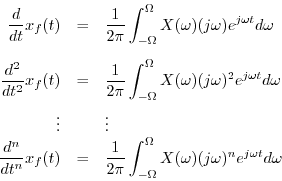Differentiability of Audio Signals
As mentioned in §3.6, every audio signal can be regarded as
infinitely differentiable due to the finite bandwidth of human
hearing. That is, given any audio signal ![]() , its Fourier
transform is given by
, its Fourier
transform is given by




Since the length of the integral is finite, there is no possibility
that it can ``blow up'' due to the weighting by ![]() in the
frequency domain introduced by differentiation in the time domain.
in the
frequency domain introduced by differentiation in the time domain.
A basic Fourier property of signals and their spectra is that
a signal cannot be both time limited and frequency limited.
Therefore, by conceptually ``lowpass filtering'' every audio signal to
reject all frequencies above ![]() kHz, we implicitly make every audio
signal last forever! Another way of saying this is that the ``ideal
lowpass filter `rings' forever''. Such fine points do not concern us
in practice, but they are important for fully understanding the
underlying theory. Since, in reality, signals can be said to have a
true beginning and end, we must admit that all signals we really work
with in practice have infinite-bandwidth. That is, when a signal is
turned on or off, there is a spectral event extending all the way to
infinite frequency (while ``rolling off'' with frequency and having a
finite total energy).E.2
kHz, we implicitly make every audio
signal last forever! Another way of saying this is that the ``ideal
lowpass filter `rings' forever''. Such fine points do not concern us
in practice, but they are important for fully understanding the
underlying theory. Since, in reality, signals can be said to have a
true beginning and end, we must admit that all signals we really work
with in practice have infinite-bandwidth. That is, when a signal is
turned on or off, there is a spectral event extending all the way to
infinite frequency (while ``rolling off'' with frequency and having a
finite total energy).E.2
In summary, audio signals are perceptually equivalent to bandlimited
signals, and bandlimited signals are infinitely smooth in the sense
that derivatives of all orders exist at all points time
![]() .
.
Next Section:
Logarithms
Previous Section:
Points of Infinite Flatness



















